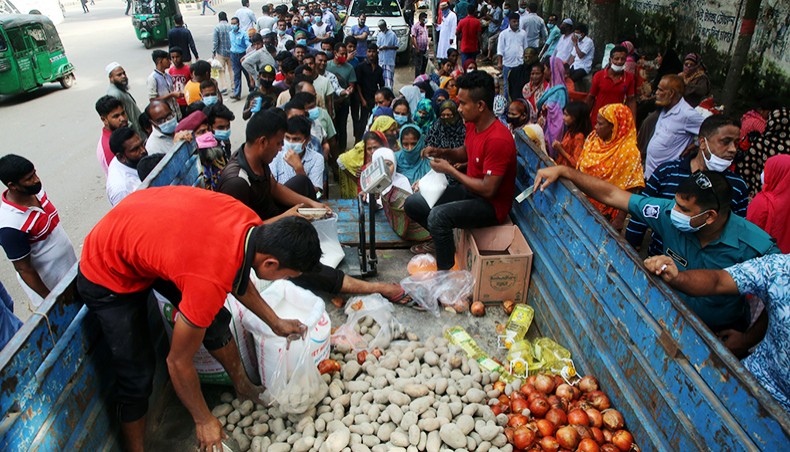Staff Correspondent
Published:2023-01-13 19:01:09 BdST
‘Inflation, commodity price shocks will sustain for next 2 years in Bangladesh’
As the New Year begins with a set of risks that feel both wholly new and eerily familiar worldwide, Bangladesh will face rapid and sustained inflationary pressure and severe commodity price shocks, which will continue for more than two years with the debt crisis, human-made environmental damage and geopolitical contestation, according to a report.
These top five risks were identified for Bangladesh in the World Economic Forum's latest Global Risks Perception Survey 2022-2023.
According to the report, governments and central banks could face stubborn inflationary pressures over the next two years, not least given the potential for a prolonged war in Ukraine, continued bottlenecks from a lingering pandemic, and economic warfare spurring supply chain decoupling.
Globally, the cost of living crisis is the biggest short-term risk while the failure of climate mitigation and climate adaptation is the largest long-term concern.
Regarding inflation, Saadia Zahidi, managing director of the WEF said: “The support given in advanced economies to keep businesses afloat due to the inflation wasn't enough. Things look grim in the advanced economies with fears of recession. However, many small businesses and people managed to stay afloat.”
The report shows that most respondents to the 2022-2023 Global Risks Perception Survey (GRPS) chose the energy supply crisis, cost-of-living crisis, rising inflation, food supply crisis and cyberattacks on critical infrastructure as among the top risks for 2023 with the greatest potential impact on a global scale.
The report also warned that the crisis could become more difficult if policymakers miscalculate fiscal and monetary policies.
It said: “A miscalibration between monetary and fiscal policies will raise the likelihood of liquidity shocks signalling a more prolonged economic downturn and debt distress on a global scale.”
Continued supply-driven inflation could lead to stagflation, the socioeconomic consequences of which could be severe, given an unprecedented interaction with historically high levels of public debt.
Global economic fragmentation, geopolitical tensions and rockier restructuring could contribute to widespread debt distress in the next 10 years.
These are being amplified by comparatively new developments in the global risks landscape including unsustainable levels of debt, a new era of low growth, low global investment and de-globalization, a decline in human development after decades of progress, rapid and unconstrained development of dual-use (civilian and military) technologies and the growing pressure of climate change impacts and ambitions in an ever-shrinking window for transition to a 1.5-degree celsius world.
Together, these are converging to shape a unique, uncertain and turbulent decade to come.
Challenges for the next decade
The next decade will be characterized by environmental and societal crisis, driven by underlying geopolitical and economic trends.
The cost-of-living crisis is ranked as the most severe global risk over the next two years, peaking in the short term. “Biodiversity loss and ecosystem collapse” are viewed as one of the fastest deteriorating global risks over the next decade and all six environmental risks feature in the top ten risks over the next ten years.
Nine risks are featured in the top ten rankings over both the short and the long term, including “geoeconomic confrontation” and “erosion of social cohesion and societal polarization,” alongside two new entrants to the top rankings: “widespread cybercrime and cyber insecurity” and “large-scale involuntary migration.”
Top risks for South Asian countries
Global Risks Report 2023 highlighted the top five risks over the next two years in 89 countries.
Report analysis shows that the top risks for South Asian countries are not the same.
While rapid inflation is the biggest threat for Bangladesh, digital inequality is the biggest one for India. For Nepal, it's geopolitical contestation of resources, digital power concentration for Pakistan and debt crises for Sri Lanka.
Saadia Zahidi said: “The short-term risk landscape is dominated by energy, food, debt and disasters. Those that are already the most vulnerable are suffering in the face of multiple crises. Those who qualify as vulnerable are rapidly expanding in rich and poor countries alike.”
The report presented the results of the latest Global Risks Perception Survey (GRPS) based on insights on the evolving global risks landscape from over 1,200 experts across academia, business, government, the international community and civil society.
In Bangladesh, the Centre for Policy Dialogue (CPD) was the partner of the WEF for the survey.
Responses for the GRPS 2022-2023 were collected from September 7 to October 5, 2022, said the report.
Unauthorized use or reproduction of The Finance Today content for commercial purposes is strictly prohibited.


